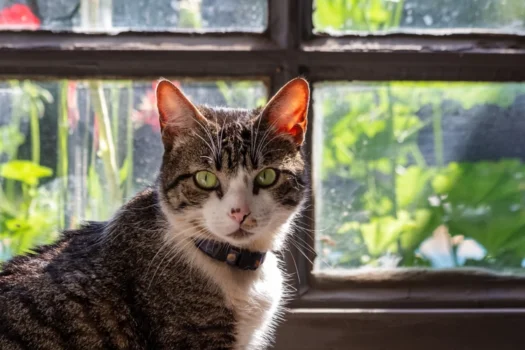As American Wirehair cat owners, we all know how important it is to maintain their litter box usage. However, when it comes to owning multiple cats, the task of ensuring every feline friend uses the litter box can be daunting. It’s not uncommon for cat owners to feel perplexed when their American Wirehairs struggle to use their litter boxes in multi-cat households. So, in this article, we’ll dive into the link between multiple cats and litter box usage and provide practical steps to improve litter box usage for American Wirehairs in multi-cat households.
The Link Between Multiple Cats and Litter Box Usage

As a pet parent to American Wirehairs, it can be concerning when you notice changes in their litter box usage. One factor that can play a major role in litter box problems is the presence of other cats in the household. According to experts, the relationship between multiple cats and litter box usage can be complex and there are several reasons why your American Wirehair may be having issues. It’s important to understand these reasons and take proactive steps to help improve litter box usage. In this section, we’ll explore the link between multiple cats and litter box usage and how it relates to your American Wirehair.
1. Cats are Territorial
Cats are territorial creatures by nature, and they have a strong instinct to protect their domains. This means that when there are multiple cats in a household, each cat may feel like they need their own space and resources. This can lead to conflict over important resources, such as food, water, and litter boxes. In particular, access to a clean litter box is critical for cats’ health and well-being. If one cat is monopolizing the litter box or is guarding it from the others, the other cats may avoid using it altogether.
To avoid territorial conflicts, it’s important to have multiple resources available throughout the household, including litter boxes. As a general rule, there should be one litter box per cat, plus an extra litter box as a backup. For example, if you have three American Wirehairs in your home, you should have four litter boxes. This ensures that each cat has access to a litter box whenever they need it.
Another strategy to reduce territorial conflicts is to make sure that each litter box is placed in a separate area of the house. This gives each cat their own “space” and can help prevent conflicts over resources. It’s also important to keep the litter boxes clean and well-maintained. Regular cleaning and scooping can help reduce odors and make it more pleasant for cats to use the litter box.
If you notice that your American Wirehair is having litter box problems despite these strategies, it may be a sign of a medical issue. Health problems, like urinary tract infections or blockages, can cause cats to avoid using the litter box. If you suspect a medical issue, it’s important to take your cat to the vet right away.
For more information on American Wirehair litter box care, check out our article on American Wirehair Litter Box Care. Additionally, if you’re looking for solutions to common litter box problems, take a look at our article on Litter Box Solutions for Wirehairs. Whether you’re dealing with territory issues or medical problems, with consistency and patience, you can help your cats adjust to sharing resources and ensure that they are all happy and healthy.
2. Competition for Resources
Cats are known for their independent nature, but when it comes to sharing the litter box, they can become fiercely competitive. Competition for resources is one of the main reasons that multiple cats in a household can lead to litter box problems. When cats feel like they must compete for the same resources, it can cause stress and anxiety, leading to litter box avoidance.
This competition is often seen when there aren’t enough litter boxes in the household. In a multi-cat household, it is recommended to have at least one litter box per cat, plus an additional one. This will reduce competition for resources and make it less stressful for your American Wirehair to use the litter box.
Additionally, if the litter boxes are not cleaned frequently enough, cats may avoid them altogether. Regular cleaning is important to avoid litter box problems. Aim to scoop the litter box at least once a day and replace the litter entirely every few days.
It’s also essential to distribute resources such as toys, water bowls, and feeding areas to avoid intense competition between cats. By spreading out resources, each cat can have their space, reducing competition.
By understanding the competition for resources issue, you can learn how to mitigate it and make litter box usage more comfortable for your American Wirehair. Additionally, if you want to learn how to set up an ideal litter box for your Wirehair, click the link to our comprehensive guide on litter box setup for American Wirehairs.
3. Medical Issues
American Wirehairs are generally healthy cats that adapt well to different living conditions. However, in some cases, litter box problems can be caused by medical issues rather than behavioral ones. It is critical to rule out any underlying health problems before implementing any litter box training routines in your American Wirehair.
Here are some common medical issues that can affect litter box usage in American Wirehairs:
| Medical Issues | Symptoms |
|---|---|
| Urinary tract infections (UTIs) | Frequent urination, straining to urinate, meowing while urinating, blood in the urine, and licking the genitals excessively |
| Bladder stones or blockages | Straining to urinate, frequent urination, meowing while urinating, and licking the genitals excessively |
| Diabetes | Increased thirst and urination, decreased appetite, weight loss, and lethargy |
| Arthritis | Limited mobility and difficulty getting in and out of the litter box |
If you notice any of the symptoms mentioned above, it is crucial to take your American Wirehair to the vet as soon as possible to rule out any underlying medical conditions. Your vet may recommend a urinalysis, blood work, or an x-ray to diagnose the problem.
Addressing any medical issues that your cat may have can significantly improve their litter box usage. By doing so, you can avoid stressing your American Wirehair by making them adhere to a litter box routine that is much difficult for them to keep up with.
When it comes to litter box problems, it is vital to emphasize that sometimes no matter how consistent you are with litter training, some medical issues may not be resolved without proper treatment. It’s crucial to prioritize your cat’s health to ensure they live long, healthy, and comfortable lives.
For more information on medical reasons for litter box problems in American Wirehairs, visit here and for information on consistency in litter training Wirehairs, visit here.
Recognizing Litter Box Problems in Your American Wirehair

Cats are generally fastidious creatures and litter box issues can be cause for concern. As a cat owner, it’s essential to be able to recognize subtle changes in your American Wirehair’s behavior that may indicate a litter box problem. Promptly addressing these issues is vital to maintain the overall health and well-being of your feline companion. Here are some key signs to keep an eye out for.
1. Changes in Bathroom Habits
It’s essential to keep an eye on changes in your American Wirehair’s bathroom habits to identify any potential litter box problems. Here are some signs to watch out for:
- Increased frequency: If your cat is visiting the litter box more frequently than usual, it might be a sign of a urinary tract infection or other medical issues.
- Decreased frequency: On the other hand, if your cat is visiting the litter box less frequently, it can indicate constipation or other urinary issues.
- Change in texture or color: Any change in the texture or color of your cat’s waste can also be a red flag. If it’s loose or if there’s blood present, it can indicate a gastrointestinal issue.
- Location: Keep an eye out for your cat going outside of the litter box, such as in corners or other areas of the house. This behavior can indicate a problem with the litter box itself or a marking behavior.
If you notice any of these changes in your cat’s bathroom habits, it’s crucial to consult with your vet right away to rule out any medical issues. And after ruling out any medical problems, it’s important to focus on optimizing litter box usage to make your American Wirehair comfortable.
2. Urine Marking or Spraying
American Wirehairs are lovely breed of cats that enjoy living with their owners. However, when you have multiple cats in a household, litter box usage can sometimes become a challenge. One of the signs that your American Wirehair may be experiencing issues with litter box usage is urine marking or spraying.
What is urine marking or spraying?
Urine marking or spraying is behavior that involves a cat urinating on vertical surfaces, such as walls, furniture, or corners. Unlike regular urination, which is done in the litter box, urine marking is a way for your American Wirehair to communicate and mark their territory. It is more common in male cats, but females can also exhibit this behavior.
Why do cats engage in urine marking or spraying?
Cats engage in urine marking or spraying for various reasons, including territorial disputes with other cats, anxiety, and sexual behavior. When there are multiple cats in a household, the competition for resources may trigger urine marking or spraying behavior. Additionally, changes in the environment, such as moving or introducing a new family member or pet, can also cause anxiety and lead to urine marking or spraying.
How to recognize urine marking or spraying?
Urine marking or spraying is easy to recognize as the urine has a strong odor, and it is usually sprayed on vertical surfaces. Your American Wirehair may also exhibit other behavioral signs such as restlessness, pacing, or scratching.
What to do if your American Wirehair is urine marking or spraying?
If your American Wirehair is urine marking or spraying, there are several steps you can take. First, make sure your cat sees a vet to rule out any medical issues. Ensure that your cat has enough resources such as litter boxes, food, and water bowls.
Next, clean the affected areas thoroughly with an enzymatic cleaner to eliminate the odor. You can also try to reduce the anxiety your cat may be experiencing by providing hideaways or vertical spaces for your cat to perch on.
Conclusion
Urine marking or spraying is a common issue that can occur in multi-cat households. It’s important to recognize the signs such as strong-smelling urine on vertical surfaces, restlessness, or pacing in your American Wirehair. By identifying the root cause of the problem and providing enough resources, you can help alleviate the behavior.
3. Avoidance
Cats are creatures of habit, and any changes in their environment can trigger avoidance behaviors when it comes to using the litter box. Avoidance can manifest in several ways and can be a significant problem for American Wirehairs in multi-cat households.
One common sign of avoidance is when a cat starts using other areas of the house as a bathroom. This behavior is often caused by stress and anxiety from sharing litter boxes with other cats. These behaviors can include urinating and defecating outside the litter box, on soft surfaces like carpets or furniture.
Another sign of avoidance is when cats refuse to use a particular litter box due to disliking the type of litter, the box’s size, or location. Finally, some cats may avoid litter boxes due to negative past experiences or painful medical conditions like cystitis or constipation, causing them to associate litter boxes with discomfort or pain.
In these situations, it’s essential to address the underlying cause of the behavior. Providing additional litter boxes with various types of litter and ensuring that they are placed in quiet or private areas can help alleviate the stress of competing for resources. Investing in larger litter boxes may also help for cats that have larger body frames.
Regular cleaning of litter boxes can also remove any unpleasant odors that might cause aversion. It’s also crucial to address any underlying medical conditions that may be causing behavior changes.
Avoidance behaviors can be a frustrating issue in cats, especially in households with multiple felines. By understanding your American Wirehair’s needs and providing the necessary resources, you can help alleviate stress and anxiety, improving overall litter box usage and your cat’s quality of life.
| Signs of Avoidance | Possible Causes | Solutions |
| Urinating/ defecating outside of the litter box | Stress and anxiety from sharing litter boxes with other cats | Providing additional litter boxes with various types of litter and ensuring that they are placed in quiet/private areas |
| Refusing to use a particular litter box | Dislike of the type of litter, box size, or location | Providing additional litter boxes with various types of litter and ensuring that they are placed in quiet/private areas |
| Avoiding litter boxes entirely | Negative past experience with the litter box or painful medical conditions | Addressing any underlying medical conditions and providing additional litter boxes with various types of litter and ensuring that they are placed in quiet/private areas |
Steps to Help Improve Litter Box Usage in American Wirehairs in Multi-Cat Households
As a multi-cat household owner, ensuring that each American Wirehair has easy access to clean and functional litter boxes is crucial. It can be a perplexing and frustrating task to monitor litter box usage for multiple cats, but with the right steps in place, it can be managed efficiently. In this section, we will outline key strategies and best practices to improve litter box usage in your American Wirehairs, even in multi-cat households. By implementing these tips, you can make a positive change for your cats’ health and happiness, and ensure that everyone in your home has access to a clean and comfortable bathroom area.
1. Additional Litter Boxes
Adding additional litter boxes is one of the most effective and straightforward solutions to improve litter box usage in multi-cat households. It’s a simple concept: more boxes means less competition for resources, fewer territorial disputes, and more options for cats to choose from. For example, if you have two cats, it’s recommended to have three litter boxes, and for three cats, it’s best to have four litter boxes.
When adding litter boxes, it’s essential to choose the right type of box for your American Wirehair cat’s needs. Some cats prefer covered boxes, while others prefer open ones. You can even try different types of litter in each box to see what your American Wirehair cat prefers. Placing litter boxes in different locations around the house can also reduce competition and territorial behavior.
Here’s an example of how you can add additional litter boxes based on the number of cats in your home:
| Number of Cats | Number of Litter Boxes |
|---|---|
| 1 | 1 |
| 2 | 3 |
| 3 | 4 |
| 4 | 5 |
By providing multiple litter boxes and strategically placing them in different areas of your home, you can help your American Wirehair cats feel more comfortable and secure while using their litter box. Remember to clean the boxes regularly and address any medical issues promptly to ensure optimal litter box usage.
2. Strategic Placement
As mentioned earlier in the article, the placement of litter boxes plays a significant role in the litter box habits of American Wirehairs in a multi-cat household. Strategic placement of litter boxes can provide separated and distinct areas for cats, reducing territorial disputes and competition for resources.
Here are some key tips for strategic placement of litter boxes:
| Tip | Description |
|---|---|
| Elevated areas | Some cats like to feel a sense of security when using the litter box, so placing some boxes on elevated surfaces might be a good idea. Just ensure that it is safe for them to access the area effortlessly. |
| Separate rooms | Placing litter boxes in different rooms can help to give each cat their own space. This will decrease any territoriality and give them a greater sense of independence and privacy. |
| Accessible areas | If your cats have mobility issues, it’s important to place the litter boxes in easily accessible areas – to help them get in and out easily. Avoid high traffic areas or areas where there is a lot of noise or activity to avoid scaring them. |
| Fixed locations | Cats might need some time to adjust to new litter box setups, so it’s important to fix the location of the boxes once established. This can help to reduce litter box accidents and confusion for the cats. |
By following these tips, strategic placement of litter boxes can greatly improve litter box usage among American Wirehairs and reduce any litter box problems in multi-cat households. Remember, keeping cats healthy and happy requires a little effort and work, so don’t hesitate to give it your best shot!
3. Regular Cleaning
Maintaining a clean litter box is crucial for the health and well-being of your American Wirehair cat. In a multi-cat household, it becomes even more essential to ensure that litter boxes are regularly cleaned to prevent any behavioral issues.
The following are some tips for regular cleaning of litter boxes:
- 1. Scoop the litter box at least once a day:
- 2. Use unscented litter:
- 3. Wash the litter box approximately every week:
- 4. Replace the litter box every six months:
Regular scooping of the litter box removes waste, preventing any unpleasant odors and keeping the litter box area clean.
While scented litter may mask the odor, it can also cause respiratory problems in cats and may discourage some cats from using the litter box. Using unscented litter is a better option.
Regular washing of the litter box removes any bacteria and unpleasant odors. Wash the litter box with unscented dish soap and hot water, and dry it before adding fresh litter.
Even with regular cleaning, the litter box may develop scratches and grooves that trap bacteria. It is recommended to replace the litter box every six months.
If your American Wirehair cat is reluctant to use the litter box, it is crucial to identify the reason for their avoidance. Regular cleaning of the litter box can prevent any issues from occurring and keep your cat healthy.
4. Investing in Larger Litter Boxes
As mentioned earlier, multiple cats in a household often means multiple litter boxes. However, just having more litter boxes may not necessarily solve the issue of litter box problems. Investing in larger litter boxes can also make a significant impact on litter box usage in American Wirehairs.
American Wirehairs are large and muscular cats, and they require bigger litter boxes that provide them enough space to move around and dig without feeling cramped. A larger litter box will not only offer more space, but it will also prevent litter from being scattered around when the cat moves inside the box.
To understand better what size litter box would be best for your American Wirehair, here is a comparison of standard litter box sizes:
| Litter Box Size | Cat Weight |
|---|---|
| Standard | Up to 10 lbs |
| Jumbo | 10-15 lbs |
| Giant | Over 15 lbs |
As American Wirehairs can weigh up to 16 pounds, you can perk out a jumbo or giant litter box to meet their needs.
While larger litter boxes will increase the initial expense, in the long run, investing in proper sized litter boxes will be much more cost-effective than dealing with problems that arise from inadequate litter boxes. Additionally, it will help your American Wirehair have a more comfortable bathroom experience, which is essential for their overall health and happiness.
Investing in larger litter boxes can be a simple yet effective way to improve litter box usage in multi-cat households with American Wirehairs. It will provide more space for your cats, prevent litter scattering, and offer them a more comfortable and enjoyable bathroom experience.
5. Addressing Medical Issues
Addressing medical issues is a crucial step in ensuring that your American Wirehair is using the litter box appropriately in multi-cat households. Some medical issues may cause cats to avoid the litter box altogether, leading to unpleasant accidents around the house. It is important to keep an eye out for any changes in your cat’s behavior and consult your veterinarian if necessary.
Below are some medical issues that may affect your American Wirehair’s litter box usage:
| Medical Issue | Signs and Symptoms |
|---|---|
| Urinary Tract Infection (UTI) | Frequent urination, straining to urinate, blood in urine, crying while urinating |
| Bladder Stones | Frequent urination, straining to urinate, blood in urine, crying while urinating, licking around the genital area |
| Constipation | Infrequent bowel movements, straining to defecate, hard and dry stools, lethargy, decreased appetite |
| Arthritis | Limping, reluctance to jump, decreased activity level, decreased appetite, irritability |
| Hyperthyroidism | Increased appetite, weight loss, restlessness, increased urination, increased thirst |
If you notice any of these signs or symptoms, it is important to consult your veterinarian as soon as possible. Treatment for these conditions may include medication, a change in diet, or even surgery in severe cases.
By addressing any medical issues your American Wirehair may have, you can help ensure that they are comfortable and more likely to use the litter box appropriately in multi-cat households.
Conclusion
In conclusion, it is important to understand the impact that multiple cats can have on litter box usage in American Wirehairs. While cats are generally clean animals, the presence of other cats in the household can lead to territorial issues, competition for resources, and even medical problems that may cause litter box problems.
As a responsible pet owner, it is essential to recognize and address any litter box problems in your American Wirehair as soon as possible. This includes observing changes in their bathroom habits, addressing urine marking or avoidance behavior, and ensuring regular cleaning of litter boxes.
Fortunately, there are several steps you can take to improve litter box usage in multi-cat households. These include providing additional litter boxes in strategic locations, investing in larger litter boxes, and addressing any medical problems that may be contributing to litter box issues.
Remember, each cat is unique, and what works for one may not work for another. It may take some trial and error to find the right solutions for your American Wirehair and their feline companions, but with patience and persistence, you can create a harmonious litter box environment that keeps everyone happy and healthy.
Frequently Asked Questions
1. How many litter boxes should I have for multiple cats?
It is recommended to have at least one litter box per cat plus one extra. So, if you have three cats, you should have four litter boxes.
2. What is the best type of litter box for American Wirehairs?
American Wirehairs are larger cats, so investing in larger litter boxes with high sides can be helpful. Covered litter boxes may also provide more privacy for shy cats.
3. Can stress affect litter box usage in cats?
Yes, stress can be a factor in litter box problems. It is important to create a calm and peaceful environment for your cats.
4. How often should I clean the litter box?
It is recommended to clean the litter box at least once a day. Cats prefer clean litter boxes and may avoid dirty ones.
5. Can medical issues cause litter box problems?
Yes, medical issues such as urinary tract infections or bladder stones can cause litter box avoidance or changes in bathroom habits.
6. How can I prevent litter box problems in multi-cat households?
Providing multiple litter boxes, strategically placing them, and keeping them clean can help prevent litter box problems in multi-cat households.
7. Should I use scented litter for my cats?
Cats have a strong sense of smell and may avoid scented litter. Unscented litter is recommended.
8. Can certain types of litter cause litter box problems?
Yes, some cats may be sensitive to certain types of litter, such as those that contain perfumes or additives. It’s important to find a litter that your cats are comfortable using.
9. What should I look for in a litter box location?
A litter box should be placed in a quiet, private location that is easily accessible to your cats. It should also be away from their food and water bowls.
10. What are some signs that my cat is experiencing litter box problems?
Changes in bathroom habits, urine marking or spraying, and avoidance of the litter box are all signs that your cat may be experiencing litter box problems.







